By Mike Chihuly
Do you belong to a small, rural fire service that struggles monthly just to pay the basic overhead bills that “keep the doors open?” Are you wondering where the money for medical supplies, vehicle fuel, apparatus repairs and insurance is going to come from next? Are you a all- or almost-all-volunteer service, but don’t know where your next volunteer is going to come from in a small community of about 200 adults that are scattered over 25 miles of highway? Do you sponsor and pay for firefighter and EMT classes to bolster your volunteer ranks but are lucky a year later to have one of them left volunteering in your department? Do you fail to meet many National Fire Protection Association (NFPA) standards because you either don’t have the testing equipment and associated expertise or the budget to buy the firefighting equipment and supplies necessary to meet those standards? Are you frustrated by failed grant opportunities because you don’t have the skills and expertise in a small community to compete in the grant writing game and/or your run volume is so low, it seems no grant evaluator will look at you anyway? Are you always on the personnel “balance beam” trying to keep board members active and manage firefighters and EMTs who know they can quit and walk away at any time if they don’t like someone or something you are doing? Are you frustrated by long response times by your responding volunteers and long travel distances to the scene that hinder the success of acute medical events and result in the suppression of many “foundation fires?” Do you set up “on call” schedules to make sure you have 24/7 coverage only to find your community without coverage much of the time? Oh…the vagaries of a small, rural fire department!

(1) Ninilchik (AK) firefighters pose with the Alaska Project Code Red “mini-firehouse” designed for small rural villages with few roads and little infrastructure.
In the ’80s, if you could walk and breath and you stepped too close to our firehouse door, we grabbed you and made you a firefighter or EMT or both. We are a little more careful these days, but still yearn to grab anyone who gets too close to our emergency service web. There is talent in my town, but getting that talent to give of themselves is difficult. People have lives: children to raise, job commitments, and food to put on the table. Our town is too small for many young people to hang around. They are looking for mates, education opportunities, jobs and other bigger and brighter things. Some of my best EMTs and firefighters over the years have been the very young, but they move on by necessity and we selfishly grieve their passing into adulthood. At one time, we had a quarter of our department between the ages of 16 and about 24. These kids were awesome. They were hard workers, eager, had “yes-sir and no-sir” respect for their elders, and they were sharp as a tack. They were capable and dedicated, and many were home-schooled, which made their schedules more flexible when emergencies arose. I remember taking five or six of them to the Alaska State Firefighter’s Conference in Seward. We were seated in a former hotel conference room overlooking Resurrection Bay and listening to the speaker, Bobby Halton. The kids loved him and it was a great fire topic and presentation. What I remember most about that experience, though, was Bobby’s incredulity and surprise when he pointed to my young firefighters and said, “How old are you guys?” He was taken aback when more than one admitted to being only 17. I would take five or six more of those “boys and girls” today in a heartbeat if I could get them!
But youth isn’t everything. We have men and women who are fishermen, domestic engineers, biologists, nurses, carpenters, mechanics, and retired military. To our credit, we have one of the oldest, if not the oldest, EMT III in the state of Alaska. He is our EMS Captain and is still cracking the whip (military man) on us all with knowledge, experience, and the energy of a 20-year-old.

(2) Community outreach is an important part of the fire service in a small town. A Ninilchik firefighter assists a young lady during “Child Education & Safety Day.”
Over the years, I have religiously read the many fire service periodicals, and we get the old issues after a period of time from our neighboring departments. In reading these magazines, what is clear to me is the large difference between the small rural departments and the larger rural and urban services that the majority of these magazine’s authors speak to. I don’t mean this in a competitive way or a “them-and-us” way. This is merely an obvious statement of fact. Many of the articles apply to all of us whether we are fighting fires or treating hypoglycemia, but there are big differences in available resources (financial and otherwise) and how we deliver our services, particularly in fire response and suppression. We are often funded differently and our personnel base is more limited. As I read these articles, I dream about having a truck company at my command, fire hydrants in town, and the ability to call for a second, third, and fourth alarm. These are things I will likely never experience as a chief in a rural department, and there are a lot of small rural services in the United States that are in the same boat. Let’s look at some of these differences.
The community of Ninilchik is blessed and surrounded by water and lots of it, yet strangely, we have very little for firefighting. Our Cook Inlet is saltwater, and every place we can get close enough to draft, the water head (height of engine verses height of water surface) is too great. We are surrounded by two famous rivers, but, again, we cannot get the apparatus close enough to their banks to draft. There are no feasible ponds or lakes available, and winter ice is present at least six month of the year. We currently fill from a tank supplied by spring water at our local fairgrounds and push the water into our tankers with a trash pump. We also take water supplied by a pump from the Ninilchik School sprinkler system. There is approximately 10,000 gallons available, but we have exhausted this source more than once on fires in the area. We desperately need a large, dependable water source with a high volume pump system for rapid fill. We have 5,000 gallons in our station on wheels, but after our initial attack, it can be an hour before we can get water back to the scene due to fill and travel times. Portable water tanks are a mainstay of our water supply system. Our nearest mutual-aid partners with water are 20 miles to the south and 25 miles to the north…a cold 20-minute ride at 20 below zero in January.
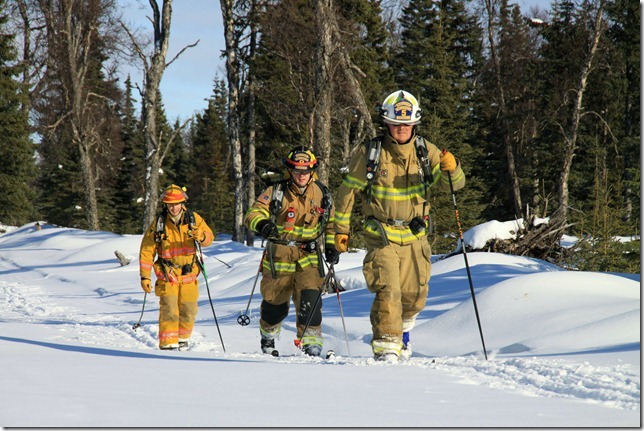
(3) Firefighter conditioning is an important aspect of keeping a small rural service healthy and ready.

(4) Winter conditions can make even doing a 360 at a structure fire a sometimes daunting task.
Our response times are often unacceptable but at the same time unavoidable. Our volunteer responders reside anywhere from two to 10 minutes from our quarters. Our station is unmanned. Our response, with EMS at least, is often shackled by the response time of our furthest out responder, especially if he or she is senior ranking and pivotal to the level of the medical call. Worst case scenario, it can take us 10 minutes to get a crew and then 10-20 minutes to get to the fire scene or the cardiac arrest victim. This is disconcerting for the homeowner whose house is ablaze or the patient and family of the heart attack victim, as well as for our responders. I read with envy about the three to five-minute response times, return of spontaneous circulation (ROSC) after defibrillation, short transport times, and the full out-of-hospital recovery for that “man down” call. These are our goal as well, but we struggle to find that similar “perfect storm” of events that allows us to make that difference in someone’s life in the rural setting. If we achieve ROSC, we can still have a 45 minute drive to a higher medical facility, and the patient is likely to have to wait another 20 minutes on the flight to the nearest catheterization lab in Anchorage.
The money situation is also a never-ending concern. I can remember sitting on the bumper of Engine One back in the early ’90s as the then frustrated chief asked for advice from his rank and file firefighters…a vote.
“What do you want to do guys? We have no money. Do you want to carry on, or should we just shut and lock the doors and let the community and borough government figure it out?”
We made some hard choices back then, and things are better today in 2013, but it is still a struggle. Ninilchik Emergency Services is a 501 c 3 non profit with no tax dollars from taxation of resident assets. Our funding comes from the sale of cookbooks and quilt raffle tickets. We put on the annual Memorial Day Pancake Breakfast, and the local American Legion Post 18 holds its annual 911 fund raiser on our behalf. We charge for EMS and fire responses, but in these economic times, billing returns are dismal. On the fire side, it is hard to charge residents $500-$3,000 for a fire suppression response when they have no insurance and just lost their home and everything but the clothes on their back. This just means there will be more fundraising for the family from a community that is already giving in every way they can.

(5) Dr. William Cooper, Ninilchik physician sponsor,with Ninilchik EMTs, inspects the new LifePak 15 acquired with an Alaska Code Blue Project grant.
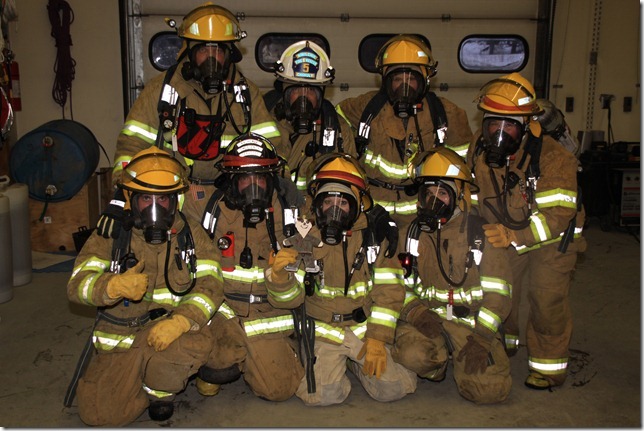
(6) Getting volunteers in a small rural service to come to training can be difficult but is crucial to safety and successful outcomes.
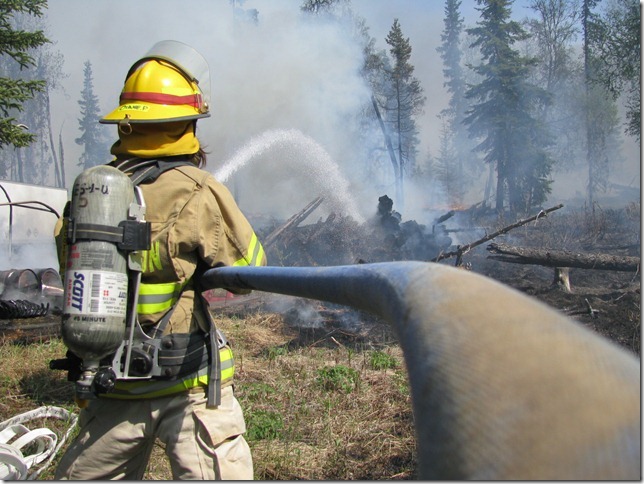
(7) Wildland-urban interfance fires are a consistent part of Ninilchik’s fire responses every summer.
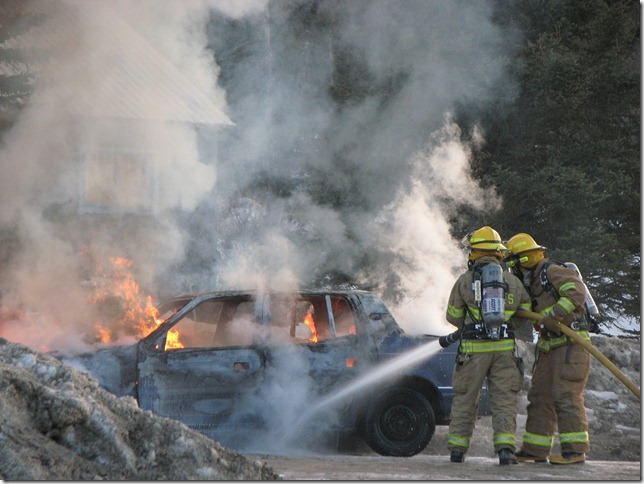
(8) Ninilchik firefighters put out a car fire on the Sterling Highway.
Many small rural services like Ninilchik also receive small matching grants from the state and local governments for fire and EMS supplies and equipment, and Ninilchik benefits from the generous Alaska Code Blue Project that has helped us purchase EMS equipment like defibrillators, gurneys, and our newest medic unit. In addition, we receive membership dues, private individual donations, and have received donations from companies like Marathon Oil, Unocal, and the Chevron Oil Company, who want to be good neighbors and make donations to our service when they are in our area for oil and gas exploration and production. These donations are usually one-time events and, although fortuitous, they are unpredictable and finite. The bottom line is that our total budget (medical supplies, overhead, training, insurance, equipment, etc.) is $110,000. We provide fire and medical service to residents and visitors on the Kenai Peninsula, serving a 250-square mile area that includes 25 miles of the Sterling Highway. We do this with two medic units, four pieces of fire apparatus, and 25 volunteers on a budget that would amount to the cost of one or two employees (factoring in wages, overtime, benefits, etc.) in an average paid department.
Many of Alaska’s small villages have no roads, no hydrants, extreme winter conditions, no firefighting capabilities, and heating fuel in the $7-$10/gallon dollar range. The village’s economies are largely subsistence-based, jobs are few, and infrastructure is sometimes non-existent. To help stem the overwhelming loss of life and property from fires, the Micro-Rural Fire Department, sometimes called “mini firehouse,” was developed with the financial leadership of the former Senator Ted Stevens and the operational guidance of the Alaska Division of Fire and Life Safety, along with many government, private, and corporate sponsors. This innovative effort to help the smallest of rural services in Alaska is called Project Code Red. It created an exceptional firefighting package that is much more appropriate for Alaska’s small rural communities, whose transportation routes use primarily trails and boardwalks. The Code Red firefighting units consist of two small wheeled (“tundra tires”) trailers that can be pulled by hand, four-wheelers, snow machine, or pickup truck. The units are designed for a defensive attack, deliver 600 gallons of eco-safe firefighting foam from 75 feet away, and provide personal protective equipment for five firefighters and multiple fire extinguishers. They carry a water pump and a 30-gallon water tank, necessary tools and appliances, a halligan, a fire knockdown tool, and an ice auger. On acceptance of these units, the village fire department agrees to keep the unit heated and readily deployable year around. They undergo 40-50 hours of basic firefighting training and receive a Basic Firefighter certification from the state of Alaska.

(9) Portable tanks and and tanker shuttles are an integral part of many small rural water supply operations.
Despite the challenges, small rural services all over the United States help many people that otherwise would be on their own. When you are 40 miles away from the nearest paid service, you have just totaled your truck, the bull moose is still in the middle of the road struggling for life and blocking traffic, your neck hurts from the star left on the windshield, and it is blowing snow with a -10º F chill factor, there is no one else. Ninilchik responders have dealt with large wildland fires, floods, medical calls, motor vehicle accidents, drownings, hypothermia, frostbite, sulfur spills, mass-casualty incidents, search and rescues, bear maulings, horse stompings, school fires, suicides, homicides, drug overdoses, and delivered two healthy babies. But like many small services, we struggle with staffing, money, resources and the associated liabilities. Small departments like ours have trouble meeting NFPA standards that make us vulnerable. Small services struggle with the likes of standards that require “self-contained breathing apparatus (SCBA) fit tests,” “pump tests,” “hose tests,” “SCBA bottle hydro-tests,” and maintaining physician sponsors, just to name a few.
However, the bottom line is that we are here to stay. If you have an emergency while passing through our town, just call 911 and we will do our best to make it better for you with some of our finest responders. But if you are someone who can make a difference in the emergency services world–whether a writer, politician, planner, fire chief, or simply a registered voter–keep the small rural service in your heart and please don’t forget about us.
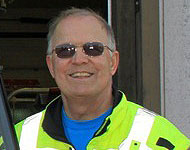 Mike Chihuly is a retired fisheries biologist and charter boat captain who has lived in Alaska for 56 years.He has been a volunteer EMT and firefighter for 29 years and the fire chief for Ninilchik Emergency Services for the last eleven.
Mike Chihuly is a retired fisheries biologist and charter boat captain who has lived in Alaska for 56 years.He has been a volunteer EMT and firefighter for 29 years and the fire chief for Ninilchik Emergency Services for the last eleven.

